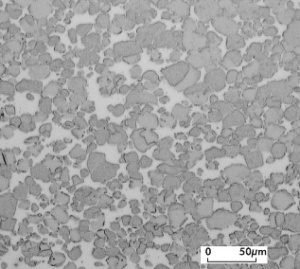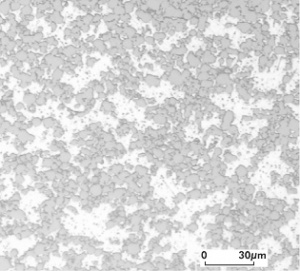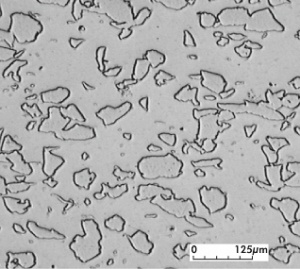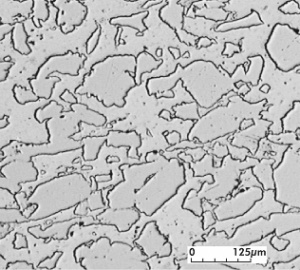Contact Materials for Vacuum Switches
The trade name VAKURIT is assigned to a family of low gas content contact materials, developed for the use in vacuum switching devices (Table 1).
| Material | Chemical Composition [wt.%] |
Density [g/cm3] |
Melting Point [°C] |
Electrical Resistivity [µΩ*cm] |
Electrical Conductivity [% IACS] |
Electrical Conductivity [MS/m] |
Vickers Hardness [HV10] |
Chopping Current (99%-Value) [A] |
|---|---|---|---|---|---|---|---|---|
| W/Cu 80/20 - low gas VAKURIT W/Cu 20 |
W: 20±2 Cu: Rest |
15,2 - 15,8 | 1083 | 4,55 - 6,25 | 28 - 35 | 16 - 20 | 210 - 250 | 5 |
| W/Cu 30Sb1 - low gas VAKURIT W/Cu30Sb |
W: 70±2 Sb: 0,5 - 1,0 Cu: Rest |
13,8 - 14,5 | 630 | 5,26 - 7,14 | 24 - 33 | 14 - 19 | 220 | 4 |
| WC/Ag 60/40 - low gas VAKURIT WC/Ag40 |
WC: 60±2 Ag: 40±2 |
12,7 | 960 | 4,34 - 5,88 | 30 - 40 | 17 - 23 | 180 - 250 | 1,5 |
| WC/Ag 50/50 - low gas VAKURIT WC/Ag50 |
WC: 50±2 Ag: 50±2 |
12,2 | 960 | 3,45 - 4,34 | 40 - 50 | 23 - 29 | 140 - 170 | 1,8 |
| Cu/Cr 75/25 - low gas VAKURIT Cu/Cr25 |
Cr: 25±1 Cu: Rest |
7,8 - 8,3 | 1083 | ≤3,70 | ≥47 | ≥27 | >60 | 4,5 |
| Cu/Cr 60/40 - low gas VAKURIT Cu/Cr40 |
Cr: 40±1 Cu: Rest |
7,3 - 7,9 | 1083 | ≤4,55 | ≥40 | ≥22 | >70 | 4,5 |
| Cu/Cr 50/50 - low gas VAKURIT Cu/Cr50 |
Cr: 50±1 Cu: Rest |
7,0 - 7,5 | 1083 | ≤6,25 | ≥28 | ≥16 | >80 | 5 |
Low Gas Content Materials Based on Refractory Metals
Contact materials of W/Cu, W/Ag, WC/Ag, or Mo/Cu can be used in vacuum switches, if their total gas content does not exceed approximately 150 ppm. In the low gas content W/Cu (VAKURIT) material, mostly used in vacuum contactors, the high melting W skeleton is responsible for the high erosion resistance when combined with the high conductivity copper component which evaporates already in noticeable amounts at temperatures around 2000 °C.
Since there is almost no solubility of tungsten, tungsten carbide or molybdenum in copper or silver, the manufacturing of these material is performed powdermetallurgically. The W, WC or Mo powders are pressed and sintered and then infiltrated with low gas content Cu or Ag. The content of the refractory metals is typically between 60 and 85 wt% (Figure 1 and Figure 2).
By adding approximately 1 wt% antimony, the chopping current, i.e. the abrupt current decline shortly before the natural current-zero, can be improved for W/Cu (VAKURIT) materials (Table 2). The contact components mostly used in vacuum contactors, are usually shaped as round discs. These are then attached by brazing to their contact carriers inside a vacuum environment (Table 3).
Low Gas Content Materials Based on Copper-Chromium
As contact materials in vacuum interupters in medium voltage devices, low gas materials based on Cu/Cr have gained broad acceptance. The typical chromium contents are between 25 and 55 wt% (Figure 3 and Figure 4). During the powder metallurgical manufacturing, a mix of chromium and copper powders is pressed into discs and then subsequently sintered in a reducing atmosphere or vacuum below the melting point of copper. This step is followed by cold or hot re-pressing. Depending on the composition, the Cu/Cr (VAKURIT) materials combine a relatively high electrical and thermal conductivity with high dielectric stability. They exhibit a low arc erosion rate and good resistance against welding as well as favorable values of the chopping current in medium voltage load switches, caused by the combined effects of the two components copper and chromium (Table 2).
The switching properties of Cu/Cr (VAKURIT) materials are dependent on the purity of the Cr metal powder and especially the type and quantity of impurities contained in the chromium powder used. Besides this, the particle size and distribution of the Cr powder are of high importance. Because of the getter activity of chromium, a higher total gas content of up to about 650 ppm, compared to the limits in refractory based materials, can be tolerated in these Cu/Cr contact materials. Besides the more economical sinter technology, also infiltration and vacuum arc melting are used to manufacture these materials. Cu/Cr contacts are supplied in the shape of discs or rings which often also contain slots, especially for vacuum load switches in medium voltage devices (Table 3). Increased applications of round discs can also be observed for low voltage vacuum contactors.
| Material/ DODUCO-Designation | Properties |
|---|---|
| W/Cu 80/20 - low gas VAKURIT W/Cu20 |
High security against welding, Low contact resistance, |
| W/Cu30Sb1 - low gas VAKURIT W/Cu30Sb1 |
Similar to VAKURIT W/Cu20, Slightly better arc chopping behavior than VAKURIT W/Cu20 |
| WC/Ag 60/40 - low gas VAKURIT WC/Ag40 |
Very low chopping current |
| Cu/Cr 75/25-50/50 - low gas VAKURIT Cu/Cr25-50 |
High security against welding during short circuits, Low contact resistance, High arc erosion resistance, High breaking capacity |
Material | Application Examples | Forms of Supply |
|---|---|---|
W/Cu 80/20 - low gas VAKURIT W/Cu 20 W/Cu 30Sb1 - low gas VAKURIT W/Cu30Sb1 WC/Ag 60/40 - low gas VAKURIT WC/Ag 40 | Vacuum contactors Vacuum circuit breakers | Contact discs, Contact parts |
Cu/Cr 75/25 - low gas VAKURIT Cu/Cr 25 Cu/Cr 60/40 - low gas VAKURIT Cu/Cr 40 Cu/Cr 50/50 - low gas VAKURIT Cu/Cr 50 | Vacuum interrupters Vacuum contactors | Contact discs Contact rings Formed contact parts |



